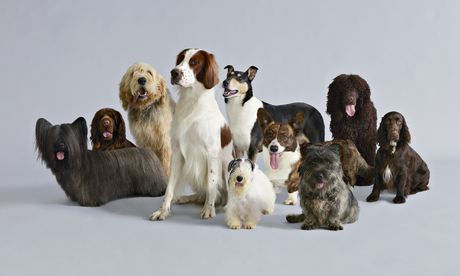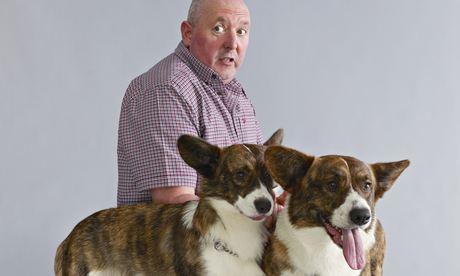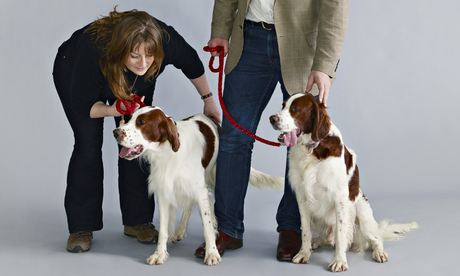Say goodbye to Skye terriers, otterhounds and Sealyhams – among the 10 most endangered dog breeds in Britain. But before we campaign for their survival, Euan Ferguson asks their owners: should we care?
Euan Ferguson

Last in show: (from left) a Skye terrier (17 pups registered last year); Sussex spaniel (55); otterhound (42); Irish red and white setter (82); Sealyham terrier (68); smooth collie (82); Cardigan Welsh corgi (102); Glen of Imaal terrier (55); Irish water spaniel (101) and field spaniel (29). Photograph: Dan Burn-Forti for the Observer
"If there is one thing constant in Britain today, it is the public's love of pedigree dogs," wrote Prince Michael of Kent in his graciously vapid intro to the weighty programme for this year's Crufts. Others might politely disagree: there are arguably finer British constants (discuss). Still, roughly 150,000 visitors, and 21,000 dogs, were on his side. The people had all been brought together through their love of four-legged good – the dogs were the focus of banter and bickering and biscuits, and myriad tales of grief and mischief.
But how constant, precisely, is our love of the pedigree dog? There is increasing evidence that pedigree breeds are falling foul of the times. There were only 17 Skye terrier pups registered last year with the Kennel Club – there might have been more born, but it's considered unlikely, as all the breeders know each other and share their hothouse knowledge. Just 42 otterhounds; 68 Sealyhams; a mere 55 of the splendid Glen of Imaal. Of the 10 most vulnerable home (British-Irish) breeds, only two in 2013 registered more than 100 births; the Irish water spaniel (thoughCrufts does insist on Spaniel, Irish Water) sneaks in at 101, and the Cardigan Welsh corgi (or for all I know, and prefer, Corgi, Welsh Cardigan), despite a brief blip in post-Olympics popularity, managed a paltry 102 registered puppies.
There are bewilderingly complex and intriguing reasons for all of this. The Irish red and white setter, for instance (82 registrations last year), almost died out because the Victorians loved the admittedly lush colour of the pure red and set themselves to breeding out the white. Thankfully it's coming back – Rough and Tumble were my absolute favourites, and owners Peter and Paula Ryan great value also. "Irish red setters are spectacular show dogs," says Peter, "but the red and whites are smarter, friendlier, calmer, stockier, lovelier. It's a question of what you see, you like. If David Beckham had a red and white, they wouldn't be endangered."
The human interjection into the genetic make-up of dogs, over four centuries, has forced singularly specialised breeds. Some were trained to sniff, others to dive into burrows of varying types, others to point towards dying prey, others to swamp and swim, others to lift dead prey in soft jaws. A select few to just tear them apart. John Essenhigh (corgis), one of the nicest chaps into whom I bumped at Crufts, mused upon this a little. "Yes, but if they had been left alone, dogs would simply have down the centuries bred themselves back into wolves." He couldn't quite be drawn on whether this would have been a good or a dreadful thing.
 John Essenhigh with Baggins and Betty, Cardigan Welsh corgis. Photograph: Dan Burn-Forti for the Observer
John Essenhigh with Baggins and Betty, Cardigan Welsh corgis. Photograph: Dan Burn-Forti for the Observer
Some endangered species have become so through changing topography. One of the aforementioned Irish water spaniels, Peaches, is today being shown by the charmingly direct Helen McLaughlin from Nottingham. "They're endangered because basically they're bog dogs, and there aren't that many bogs any more in Ireland. Styles of hunting change. The English water spaniel, for instance, died out in 1912. And many people can't be faffed today with caring for the coat, which is oily and hard work, and moults; it suited them well in the water, coupled with their barrel ribs. But they're gorgeous."
Should we be worried? Species die out all the time, have done since way before the time of the dodo. On my return from Crufts, I contacted Richard Griffiths in Dyfed, chairman of the Otterhound Club, who also keeps Sealyhams (both breeds on the vulnerable list), to try to find out why it mattered.
"We should always, surely, care about the extinction of any species," said Griffiths, "just because… who knows? What might happen?" He offered up an esoteric vision. "For instance, I used to breed Grand Bleu de Gascognes. For some reason, they produce superior milk, a special milk. I'm not necessarily advocating the, um, milking of dogs, but just think: if in the future it was found that some specialist drug, some cancer-curing drug, required some substance unique to dog milk – all right, it's fanciful, but just say – and we had literally let the drug, the only species able to produce it, literally let it die out…"
It's a dreadfully fine line, being possessed of a rare dog or watching, hapless, as it dies out. Fran Grimsdell in Norfolk, a happy proselytiser for the English setter, remembers: "When, a few years ago, the Kennel Club first publicised the vulnerability of the breed – oh God, it was like a sudden dam had broken. We and all breeders were just smothered with phone calls. We couldn't keep up with demand at all.
"Obviously all life must thrive, and the death of any species is a quiet tragedy. But the thing everyone has to remember is that with dogs you must research a bit. It's not enough to think: 'That's cute.' Specialist dogs have been bred with specialisms. English setters, say: they have to have a bounded garden and a decent bit of exercise – no good having a 200-acre farm in the country and letting them wander about; they'll just go for sniffs and run away for miles and eventually starve or be run over. Setters just do that. Oddly enough, London suburbs are good, with many fine and secure parks. Essentially we were probably up about maximum level in the 1970s with 900. Now we're too low. ."
 Paula Ryan with Irish red and white setters Rough and Tumble. Photograph: Dan Burn-Forti for the Observer
Paula Ryan with Irish red and white setters Rough and Tumble. Photograph: Dan Burn-Forti for the Observer
Helen and Peter and Paula, and in fact every other owner-breeder I spoke to at Crufts, also evince an acute understanding of another problem. In 2008 the BBC aired an investigative documentary entitledPedigree Dogs Exposed. It sent the Kennel Club, reeling, to its smelling salts with allegations of a tawdry lack of genetic testing and rampant pedigree inbreeding. A Cavalier King Charles spaniel was shown thrashing about in hopeless pain due to something called syringomyelia – too small a skull for the brain, which was likened to a size 10 foot being stuffed into a size six shoe: roughly a third of the breed suffers thus. Bulldogs were similarly damned, with their genetically modified savage underbite (but bulldogs have always been horrible, yes?). The BBC cancelled coverage of Crufts the next year on the back of it.
The breeders, and the club, do appear to be bouncing back. Helen, for instance, is pitch perfect on current methods for hip testing on Irish water spaniels: "There's a scale of 0-53 on hip displacement, and the average is 17. There's a whole new ethos to testing and proper breeding and care." She talks about the introduction of pet passports. Peter Ryan is a touch more blunt. "They've been circling the wagons since that documentary. I watched it: dreadful woeful stuff. That poor spaniel. But – look around you – this is middle England at play. They take play seriously, so they're going to fight back, and they've been doing so pretty responsibly. I just don't think they should, the public mood should, scapegoat all pedigree breeders. For example, there are many problems with the so-called 'designer dogs', the labradoodles and cockerwhoojies. You take a breed with a proven provenance to heart disease, say, and cross it deliberately with one with a history of poor eyesight and you're simply asking for problems."
Robin Hargreaves, head of the British Veterinary Association, warily agrees. "People can easily pay £800 for a labradoodle. Might be fine. But it's early days. There are fads, but there are also genetic considerations, which we are, and should be, taking seriously – 50 years hence, who knows?"
There are, at Crufts, many things to sneer at if you're so inclined. The "heelwork to music", poor buggers. The coats and cots which cost more than you'd spend on your kids. But then there are the dogs: the soft-coated Wheaten terriers, all of whom I want as a duvet, the Turkish Kangal, the Coton de Tulear, even the scrote-ugly bulldogs.
And the Skye terriers. This most vulnerable doggie – just 17 whelps last year, you might recall – was once the most famous dog in Scotland, if not Britain, immortalised in the shape of Greyfriars Bobby. Yet "people have forgotten they exist," says Sue Breeze, who has just taken best in breed for Lampard, a dog that bears a disconcerting resemblance to Cousin Itt from the Addams Family. Her friend and co-exhibitor Hazel Proud talks eagerly about the strides the Kennel Club has been making – imported semen, checks for hip and elbow dysplasia and the like – and the recent fiercely monitored DNA and genetic tests under the auspices of theAnimal Health Trust. "They are very closely bred today because of the worry about numbers. But we still try, very hard, to be careful," she says.
In truth very few of the owners and breeders seem particularly put out by the diminishing numbers of their favoured breeds – bothered, but not that bothered. Bev White, here with her smooth collie Charlie, has half-heard the comment from Peter earlier about the ability of the likes of Beckham to boost breed demand exponentially. "All well and good, and I'd hate to see any breed dying out," she says. "But I'd have to say thanks, but no thanks."
What is increasingly obvious is that there are fads for dogs. The Victorians adored the cochineal splendour of the full red setter, and recently there has been a rise in the take-up of "handbag dogs" after Paris Hilton was photographed with successive chihuahuas named with corresponding degrees of saccharine intensity. Chihuahua registration in Britain four years ago was upwards of 6,000; the sexiest dog these days is apparently the Siberian husky. But fads change. Take the Sussex spaniel: I enjoyed a good chat with Chris Hastings and his chum Merlin. After the Second World War there were only seven alive. Today there is still just a relative handful of births registered – 55 last year – but Chris says there has been recent unprecedented demand: "There are always more people wanting them than there are dogs available." These spaniels are low-slung and strong-legged, well suited to the heavy clay of Sussex, and "prone to stubbornness". They are also lively and endearing, but susceptible to deafness, hot spots (wet eczema) and a dangerous thing called bloat: but it says a lot, much of it decent, that these have all been bred from so few, without obvious catastrophies.
Two things seem apparent. First, the Kennel Club has been shamed into sharpening up many aspects of its act. There now exists a welter of websites giving decent advice on complex genetic testing and such arcanery – if they've been fighting back, they haven't been doing too shoddy a job. Secondly, and crucially, despite our expectations of infinite choice, Britons must give a twitch of thought about what should become a constant companion. As Peter Ryan dragged me back to say: "Never forget – once you choose a dog, you are everything to them. To the end of a life." Research the dog, rescue dogs included: is it a setter, a hound, a terrier, or any mix of the above; what has it been bred for, what are its concomitant needs? And can you cope?
Richard Griffiths, of the otterhounds, laughs politely at my stupid suggestion that his doggies still hunt otters. "Otters have been protected for years. Just American mink, these days. And sometimes humans. They sometimes hunt people for fun, theirs and ours. Both get exercise, obviously; it's usually someone they know well. It can be a good chase."
Does anyone get, um, hurt? "Course not. The dogs can feather on a scent which is 14 days old – but they're for smelling, tracing, pointing, not killing."
Richard was a fine chap, with the best intentions, but made me think. Is it heresy to wish the wolves hadn't died out so soon, and could have hunted down, on behalf of all doghood, those breeders in centuries past who so diligently insisted on putting the needs of their farms, and leisure, so high above the needs, breeds and health of dogs, to the point of their near-extinction?
For more information on breeds and breeders, contactthekennelclub.org.uk
No comments:
Post a Comment